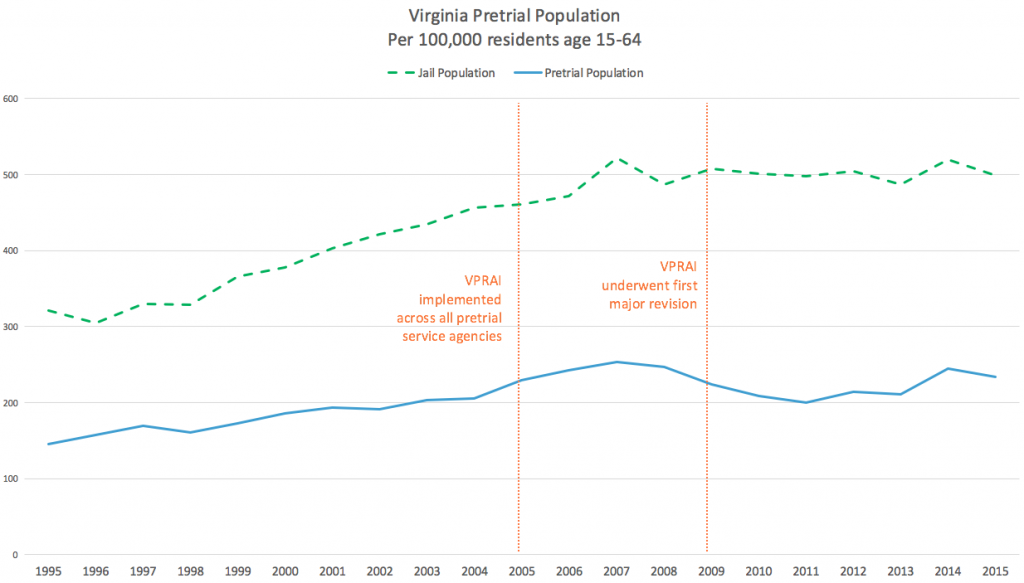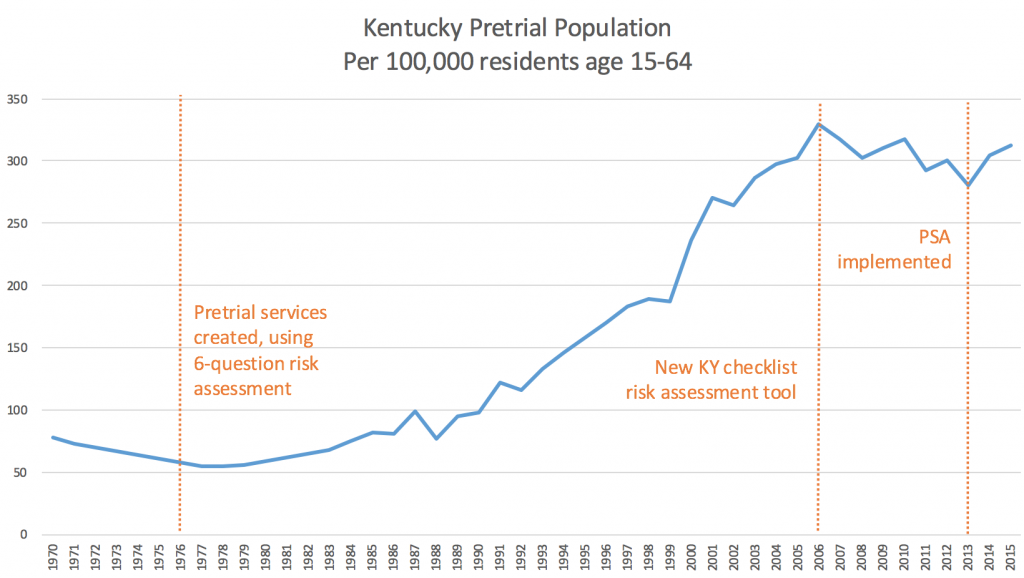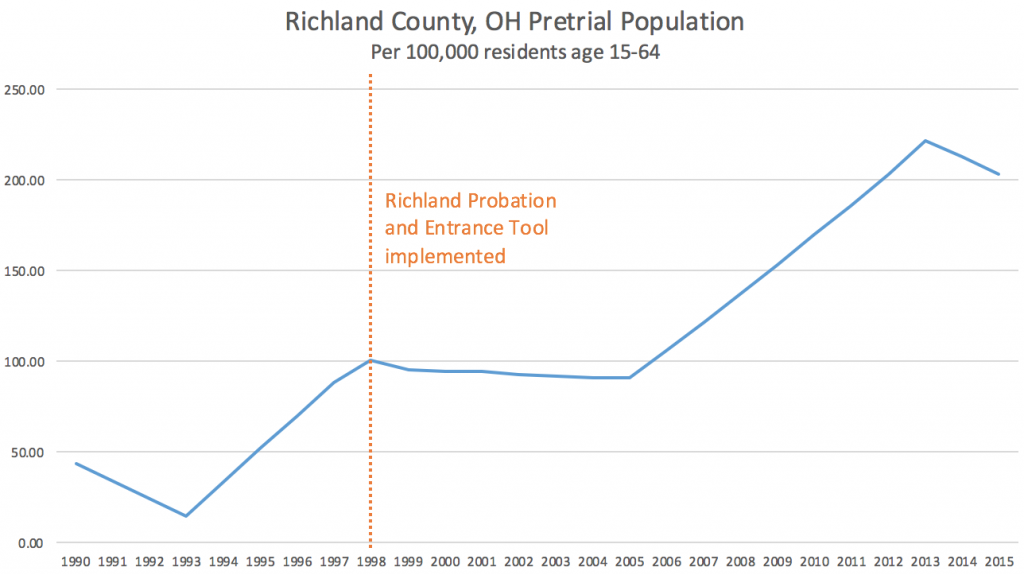In many cases, RATs are being touted as the most effective and efficient way to drastically reduce pretrial jail populations.
Many jurisdictions are turning to pretrial RATs as the key to criminal legal reform and decarceration efforts,1John L. Koepke and David G. Robinson: Danger Ahead: Risk Assessment and the Future of Bail Reform, Washington Law Review and to replace the monetary system of money bail. In some places, the use of pretrial RATs has helped to lower the jail population – especially when assessments are used to release the majority of those arrested.
However, data from several jurisdictions using pretrial RATs show that using these tools does not automatically reduce pretrial jail populations.
Movement Alliance Project communicated with 52 jurisdictions about the impact of pretrial RATs on their jail populations, alongside our secondary source research. Only nine jurisdictions told us that their jail populations had decreased alongside the use of the tool.
Two-thirds of those we spoke to either stated they do not track data regarding changes in their jail population size or were not able to tell us anything about the impact of the RAT on jail population size.
If RATs are meant to reduce jail populations, but jurisdictions do not keep track of this change, then we cannot make definitive claims about their impact on jail population size.
Three of the eight cities that received MacArthur grants to reduce jail populations actually increased their populations in the first year of the grant. Spokane County, one of those three cities, started using a RAT but increased their jail population by 10% in the first year.2Rachel Alexander and Chad Sokol: A Year After New Effort to Decrease Spokane County Jail Population, More Inmates Were Behind Bars, The Spokesman-Review
In Virginia, research showed that the VPRAI-R is not implemented early enough in the pretrial process to be able to actually decrease pretrial detention rates.3Stacey Feindt: Detained by Data: A Critical Analysis of the Virginia Pretrial Risk Assessment Instrument, University of Mary Washington The way that the pretrial process is set up there means that some are held on a bond for up to several days in jail before they are assessed with the VPRAI-R and ultimately released as low risk.
Under the original VPRAI, pretrial detention rates and the jail population in Virginia increased4Stacey Feindt: Detained by Data: A Critical Analysis of the Virginia Pretrial Risk Assessment Instrument, University of Mary Washington between initial implementation in 2005 and the most recent data in 2015. According to this researcher, the increase in pretrial population is due to a number of systemic factors, none of which are mitigated by their RAT.

Baltimore, Maryland, has used various risk assessments in the city’s pretrial services release program for over 50 years. However, in attempting to limit money bail, more and more people are being remanded without bail at all, and from March 2017 to March 2018 the average daily jail population increased by 31%.7Scott Shackford: Bail Reform efforts are backfiring in Baltimore, leading to more people stuck in jail, Reason: Free Minds and Free Markets
Data from the Vera Institute of Justice8Vera Institute of Justice: Incarceration Rates on pretrial populations combined with the start dates of various tools further illustrates that in many jurisdictions, pretrial jail populations do not automatically drop when a risk assessment tool is introduced. In some jurisdictions, the pretrial population actually increased after a pretrial RAT was implemented, as seen in the graphs below.

Kentucky’s state law has required the use of a pretrial risk assessment tool since 2011, but, as researcher Megan Stevenson found, the pretrial release rate has remained mostly stagnant. While judges initially released more people assigned low and moderate risk scores, the number of those assigned high risk scores increased. After a couple of years, judges returned to their previous practices and the pretrial release rate actually increased to pre-2011 levels.11Megan Stevenson: Assessing Risk Assessment in Action, George Mason University

This graph showing the data from Richland County, Ohio, demonstrates a clear increase in the pretrial population after a RAT was introduced.
Pretrial populations often fluctuate based on overall jail populations in a jurisdiction, regardless of the intent or impact of a risk assessment tool. There are a lot of factors that may impact jail populations: increases or decreases in arrests, decriminalization policies or new enforcement of previously unenforced local laws, overall population changes, or restructure of jails and prisons.
Regardless, most of the jurisdictions we spoke to do not have data to support the claim that pretrial RATs decrease jail populations.
And, in some cases, the proportion of those jailed pretrial rise with respect to the overall jail population, such as in Penobscot, Maine, after they began implementing the VPRAI in 2004.13VPRAI implementation date from MAP interview, May 23, 2019. See Interview Summary for more information

Even when the jail population does decrease, the risk designations of RATs can still have harmful impacts on many.
Chicago, which uses the PSA, saw a nearly 20% decrease in the jail population between September 2017 and August 2019. Those deemed low risk are released 97% of the time.15Ethan Corey: How a Tool to Help Judges May Be Leading Them Astray, The Appeal
However, judges still set high bails for those deemed “high risk” or detain them completely – even though 99% of those who are identified through the PSA as high risk for violence do not reoffend.16Ethan Corey: How a Tool to Help Judges May Be Leading Them Astray, The Appeal
The potential benefit of RATs on pretrial and jail populations can also be vastly overstated.
Mecklenburg County, North Carolina, released a study in 2019 detailing the use and impacts of the PSA there.17Cindy Redcross, Brit Henderson, Luke Miratrix, and Erin Valentine: Evaluation of Pretrial Justice System Reforms that use the Public Safety Assessment: Effects in Mecklenburg County, North Carolina, MDRC Center for Criminal Justice Research They found that although they did see a higher rate of pretrial release, fewer guilty pleas, and a lower use of bail alongside implementation of the PSA, most of these changes occurred at a stage in the pretrial process before an individual would be assessed by the PSA at all. Therefore, “it is nearly certain that factors other than the use of the PSA report contributed greatly to the observed effects.”18Cindy Redcross, Brit Henderson, Luke Miratrix, and Erin Valentine: Evaluation of Pretrial Justice System Reforms that use the Public Safety Assessment: Effects in Mecklenburg County, North Carolina, MDRC Center for Criminal Justice Research
Using RATs often overstates the supposed danger of those labeled as high risk. And the tools only work if judges actually follow their recommendations, which may or may not happen.

